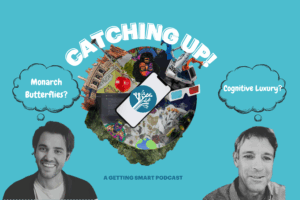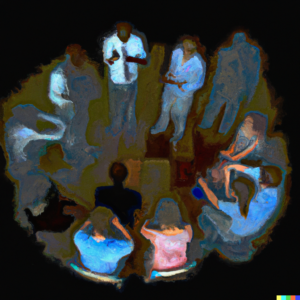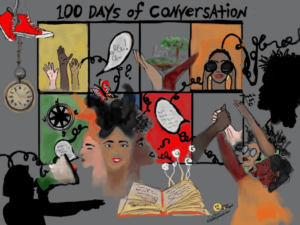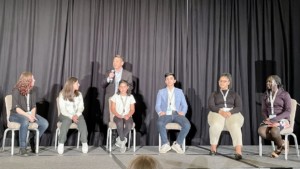BLENDED: A Conversation With Michael Horn & Heather Staker

Team Christensen is out with an updated implementation guide to blended learning.
BLENDED: Using Disruptive Innovation to Improve Schools (out November 3) suggests that “Innovating is a process, not an event.” Their new resource lays out that process in a useful level of detail making it a must read for educators that want to take full advantage of tech-enabled learning.
It may go without saying that this duo knows what they are talking about–the digital learning cognoscenti have designated authors Michael Horn and Heather Staker the deciders when it comes to blended models.
Why this book? “Technology is certainly sweeping into schools at a breathtaking pace,” said Staker. “In some cases schools are using screens to bring remarkable learning opportunities to students on all ends of the spectrum. In other cases, however, the devices make little impact, or even worse, introduce a worrisome distraction.”
“One of the biggest mistakes schools are making is to fall in love with the latest devices and invest in technology for technology’s sake,” said Stacker. “The purpose of BLENDED is to help schools maximize the unprecedented potential of technology to improve learning and avoid the common error of paying for computers that largely go to waste.”
“Even with all the resources out there, far too many schools are either neglecting the opportunity that technology holds to help personalize learning at scale or are leading with the technology rather than their education goals, which generally results in spending a lot of money and missing the promise,” said Horn. “What’s lacking still for educators has been a strategic design guide–informed by robust theory–to help them with the “hows” of putting blended learning into action to boost achievement for their students.”
“This book could not have been written 5 years ago for the simple reason that the number of success stories in schools just didn’t exist,” said Horn. “The fact that we could tell the stories we have in this book along with the data–spiking numbers of students engaged in blended learning across the country–shows that we’re making progress, even as not all blended-learning programs are achieving anything close to their promise yet.”
Outline. The book is presented in 4 parts
- Understanding: A review of models and implementation options
- Mobilizing: Where to start? How to frame the initiative? How to staff the team?
- Designing: Motivating students, teaching roles, space planning
- Implementing: Creating a powerful culture, discovery driven planning
“Improving schools does not need to be a matter of guesswork,” said Staker. “The value of sound theory is that it provides a pattern for what to do to be successful. BLENDED describes a step-by-step process for harnessing the most promising innovations to improve schools while avoiding the landmines.”
Aims. On the motivation for the book, Staker said, “I feel deeply sad when I see how many children do not have equal opportunities to high-quality schools. It’s wrong that in a rich country with universal public education, zip code determines quality.” But she feels fortunate to be living through the learning revolution where internet connectivity and personalized learning is “decimating old constructs about who gets what and introducing a new paradigm of shared access to the best learning experiences, regardless of geography.”
Horn said, “This work marries robust theory with case studies of real schools getting it right for the first time in one book to create a strategic design guide that’s a “how to” for blended learning–or really any innovation in schools.”
Quotes. Following are five great quotes that provide a sense of the big themes.
- Potential. “Blended learning holds enormous potential to transform our factory-model education system into a student-centered design that captures the benefits of personalization, equity and access, and cost control.”
- Mindset. “Adopting [an] innovation mindset will be critical to achieving success. Although blended learning offers enormous potential to personalize learning for student’s distinct learning needs and to free up student and teacher time to focus on many of the activities that are critical to student success but too often receive short shrift today, it’s still early days.”
- Planning. “When launching something unfamiliar and unpredictable, for which the ratio of knowledge to hypotheses is low, educators need to change the planning and design process.” And, “In a discovery-driven planning process, the key is to start with the desired outcome in mind. From there, the crucial next step is to list all of the assumptions that must prove true in order to realize the desired outcomes. With the assumptions in hand, the next step is to implement a plan to learning–as a way to test, as quickly and cheaply as possible, whether the critical assumptions are reasonable.”
- Pacing. “The good news is you don’t need to rush and do everything at once.” And, “Start with an overall plan with the sequence of stages and time frame in mind, but treat this as a discovery-driven plan as well.”
- Teaming. “Blended learning is a team sport.” and “Everyone has a role to play in blended learning.” Horn and Staker suggest that, “Teachers can start innovating right away and boost learning by flipping their classrooms or implement a station rotation.” And, “Administrators can support bottom-up approaches from teachers by encouraging and facilitating their efforts to innovative.” They recommend that, “Parents should be involved in any innovation effort.”
Turning Point. In 1984, Physicist Fritjof Capra argued that we were at a Turning Point in civilization. His work helped kick off a new era of science, ecology, and systems biology.
While people often believe their circumstances to be unique, it is the gift of leaders to spot patterns that suggest historical inflections. Like Capra’s contribution to science, Horn and Staker are among a few dozen wise seers interpreting the signs and illuminating the emerging learning opportunity.
“We are so fortunate to be working in education at a time of the first disruptive innovation in education in over 500 years that gives us the opportunity to scale the benefits of a tutor to every child,” said Horn. “Allowing all children to dare to dream and helping each child realize his or her fullest potential is unbelievably important and exciting.”
BLENDED stands out for its focus on how to genuinely transform learning using the disruptive innovation of online learning. It combines theory with application to provide a comprehensive design playbook for implementing blended learning–and this new way to learn may just change the world.
For more, see:
- Blended Learning Implementation Guide
- Navigating the Digital Shift (a free PDF with the BL guide and 10 other papers)
- 30 Attributes of Next Gen Learning








0 Comments
Leave a Comment
Your email address will not be published. All fields are required.